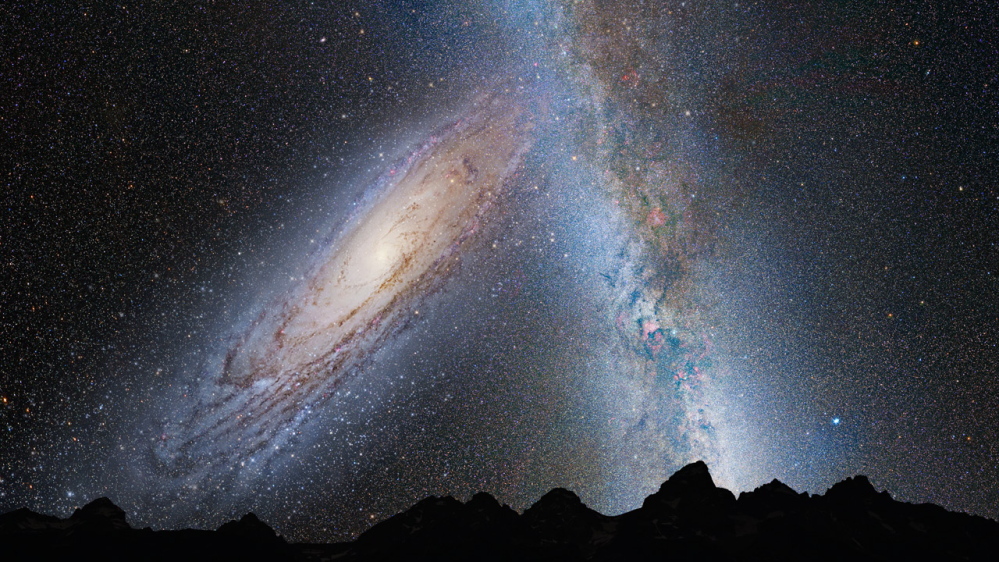Clear as a bell over the treetops northeast of my backyard August and September evenings rises the lopsided W of Cassiopeia. If you trace the line formed by the third and fourth stars from left to right and continue on southeasterly, your eye runs into a large box of four stars, known as the Square of Pegasus. The brightest of those four stars, the one your eye runs straight into coming out of Cassiopeia, is Alpheratz.
None of this is of any further interest. I’m just getting you oriented to what’s coming.
A little more than halfway from Cassiopeia to Alpheratz on a clear night with no lights around, dip your eye down a bit. If you’re patient, you’ll see a faint white smudge, just at the lower limit of visibility because it’s so diffuse. With binoculars you can see it pretty easily.
It’s the Andromeda galaxy, or M31 as stargazers call it. It’s the only large galaxy visible by naked eye from Earth. (The Large and Small Magellanic Clouds are bright and striking in the Southern Hemisphere, but despite their apparent size, they’re much smaller galaxies in our Local Group.)
Dimensions: The Milky Way, where we live, is a spiral-shaped assembly of 100 billion to 400 billion stars (or possibly more, depending on whose estimate you use). It spans about 100,000 light-years across. We’re about three-fifths of the way from the center in one of the arms, and are trundling with billions of other stars around the center — which is anchored by at least one supermassive black hole — about once every 225 million years.
M31 is a somewhat larger, less compact version of the Milky Way. It spans about 250,000 light-years and may have as many as 1 trillion stars. You’d think a clump of hundreds of billions of stars would be pretty bright in the sky, but of course M31’s faintness results from its more or less incomprehensible distance: It’s somewhere between 2.4 million and 2.9 million light-years from us. (A light-year, for the record, is the distance light travels in one year, going 186,000 miles per second.)
Once your eye knows how to find it, M31 works a certain magnetic effect on your mind. At least, for me, I can’t look into autumn skies without marking Cassiopeia, tracing the line through Andromeda to Pegasus, and flipping slowly down until I come onto it. Often I don’t catch it immediately, and have any number of times stalled my wife’s schedule of events by going back inside to get the binoculars so I can seize the night.
It’s awesome when you glimpse its chalky wisp, unsettling when you focus long enough to sort out parts (the center is much brighter than its outer fray), wider yet as your eye picks up more and more of its 2.5 million-year-old photons, and after a while it can send electrical transmissions of cosmic fear up your spine and into the core of your brain that processes unutterably deep affinities. Almost like you had lived there once and were recognizing home. Or something.
Something too much of this.
This is just what it looks like now, mind you. It was observed decades ago that M31 is actually moving in our direction. And recently some astronomers projected their scientific vision further into the future and found it’s likely the Milky Way and M31 will collide some 4 billion years from now. “Collision” sounds ominous, but because of the gigantic empty spaces between stars, the two galaxies should for the most part simply sweep in silent slow motion through each other, like ghosts through walls.
“The statistical likelihood that the sun will strike another star is extremely low ([though] not zero),” astrophysics professor Neil Comins at the University of Maine told me when I asked him to speculate on what such a collision might look like from here. “It is more likely that the gravitational attractions of passing stars from M31 will cause the Earth and other objects in the solar system to change orbits. Depending on how elliptical our orbit became, that could severely affect life on Earth.
“That is, if there is any life here in 4 billion years,” he wrote, “which is shortly before the sun will end the life-supporting phase of its evolution.”
What will it look like? Right now it’s that just-visible wisp of light. In 500 million years, it will be larger, brighter and easy to spot over whatever tree line might survive here. In a billion years, maybe it will have a presence somewhat similar to the Magellanic Clouds now, smaller but with a hair-raising elliptical symmetry slashing angle-upward in the sky. In 2 billion years, it dominates the horizon. In 3.75 billion years, it’s filling autumn evenings — if such things still exist — looming over any humans who might be left like the gigantic, terrifying face of an angel.
By then our constellations will have all dissolved, because the stars will have made more than 17 circuits around the galactic center and wandered away from the spots we see them now. M31’s gigantic gravity will be pushing and pulling everything out of its comfort zone in any case. In 4 billion years, the sky is filled with light. The upper limits of visibility are all reshaped.
But that will be then. This is now. For now.
Dana Wilde lives in Troy. He is a contributor to “Pluto: New Horizons for a Lost Horizon” available from North Atlantic Books. You can contact him at naturalist1@dwildepress.net. Backyard Naturalist appears the second and fourth Thursdays each month.
Copy the Story LinkSend questions/comments to the editors.




Success. Please wait for the page to reload. If the page does not reload within 5 seconds, please refresh the page.
Enter your email and password to access comments.
Hi, to comment on stories you must . This profile is in addition to your subscription and website login.
Already have a commenting profile? .
Invalid username/password.
Please check your email to confirm and complete your registration.
Only subscribers are eligible to post comments. Please subscribe or login first for digital access. Here’s why.
Use the form below to reset your password. When you've submitted your account email, we will send an email with a reset code.